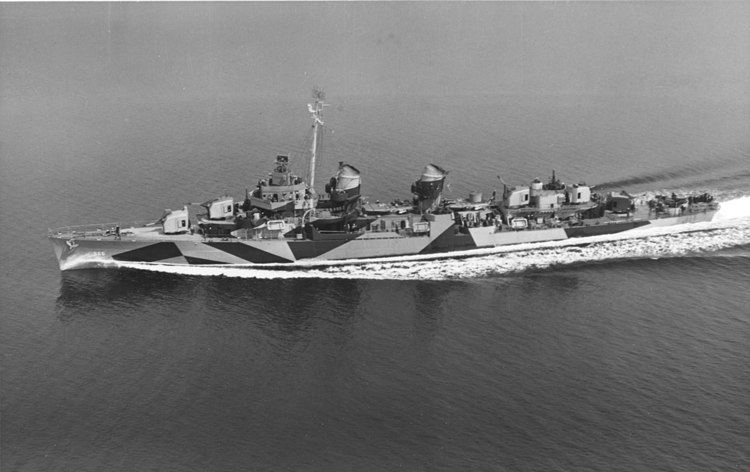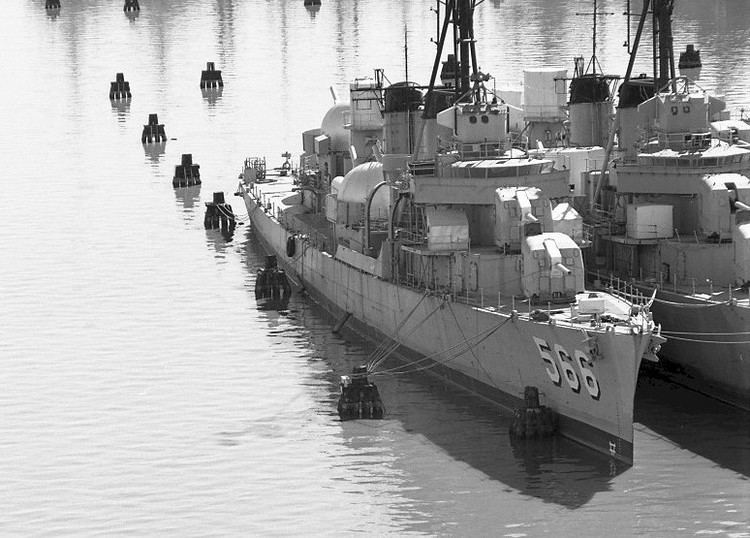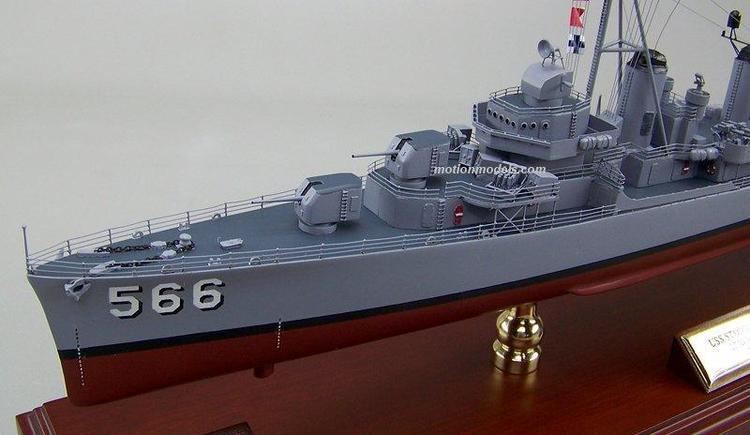Namesake James Stoddard Commissioned 15 April 1944 Struck 1 June 1975 Launched 19 November 1943 | Laid down 10 March 1943 Decommissioned 26 September 1969 Construction started 10 March 1943 | |
Fate Sunk in an exercise, 22 July 1997 Builder Seattle-Tacoma Shipbuilding Corporation | ||
USS Stoddard (DD-566) was a Fletcher-class destroyer of the United States Navy, named for Master's Mate James Stoddard, who was decorated for heroism during the Civil War. She was the last Fletcher to be stricken from the U.S. Navy, in 1975.
Contents
- World War II
- North Pacific campaign
- Battle of Okinawa
- 1950 1965
- Vietnam War 1965 1968
- 1969 1997
- Fate
- Honors
- References
Stoddard was laid down at Seattle, Wash., by the Seattle-Tacoma Shipbuilding Corp. on 10 March 1943; launched on 19 November 1943, sponsored by Mrs. Mildred Gould Holcomb; and commissioned on 15 April 1944, Commander Horace Meyers in command.

World War II

Following shakedown training out of San Diego and an availability at Seattle, Stoddard screened a convoy to Pearl Harbor, departing the west coast on 16 July and reaching Hawaii on the 29th. She entered another brief availability period at Pearl Harbor, then headed north. On 8 August, she arrived in Adak, Alaska, and joined Task Force 94 (TF 94), made up of light cruisers Trenton (CL-11), Concord (CL-10), Richmond (CL-9), and the destroyers of Destroyer Division 57 (DesDiv 57).
North Pacific campaign

The mission of TF 94 was to harass Japanese outposts in the Kuril Islands, located to the northeast of Japan proper and west of the Aleutian Islands. On 14 August 1944, Stoddard sailed with the task force to make her first offensive sweep of those forward enemy positions. Poor weather conditions forced the ships to abandon the mission. Task Force 94 was redesignated TF 92 between that first abortive mission and the second one, begun on 26 August. Foul weather again foiled the American attack, and the task force put into Attu. The storms were so bad and came so often that TF 92 did not pull off a raid until late November.
During the evening hours of 21 November, the cruisers and destroyers pounded the Japanese installations at Matsuwa, damaging the airfields and other installations heavily. Heavy winds and seas slowed TF 92's retirement to nine knots, but, at the same time, stopped enemy air pursuit. The warships returned safely to Attu on the 25th.
From Adak, DesDiv 113, including Stoddard, was routed to the submarine base at Dutch Harbor. After spending the first two weeks in December at Dutch Harbor, the destroyers put to sea on the 13th and rejoined TF 92. On 3 January 1945, the task force embarked upon another sweep of Japan's Kuril defenses. Two days later, under the cover of snow squalls but with calm seas, the task force bombarded the Surabachi Wan area of Paramushiro, severely damaging canning installations and airfields. TF 92 retired to Attu at high speed and returned to Dutch Harbor on the 13th for a ten-day recreation period.
On 16 January, Stoddard and Rowe (DD-564) headed south for operational training in the Hawaiian Islands. They arrived at Pearl Harbor on the 22d and departed on 7 February to return to Attu. They reached Massacre Bay on 13 February, just in time to join the group headed for the bombardment of Kuabu Zaki. The ships put to sea on 16 February and arrived off Paramushiro just after sunset on the 18th. They bombarded the island until midnight and then retired to Attu, where they arrived on the 20th. Three days later, they shifted to Adak for supplies and repairs. They returned to Attu on 8 March. On 15 March, they hit Matsuwa again. From 1 to 17 April, Stoddard joined the task force in exercises in the vicinity of Adak. On the 18th, she and the rest of DesDiv 13 bade farewell to the cold winds and waters of the Aleutians chain.
Battle of Okinawa
Stoddard entered Pearl Harbor for the third time on 24 April 1945. For almost a month, her crew enjoyed recreation in the islands and conducted operational training in preparation for assignment to Okinawa and the Fast Carrier Task Force. Stoddard sailed from Pearl Harbor on 11 May, in the screen of Ticonderoga (CV-14), bound for Ulithi. Along the way, Ticonderoga's air group got in a little live-ammunition practice on 17 May, when they struck the Japanese forces isolated on Taroa and the other islets of Maleolap Atoll. The task group reached the lagoon at Ulithi on 22 May. A week later, Stoddard departed the atoll to take up station off Okinawa.
On 2 June, she arrived off Okinawa and took up radar picket station. Though the Okinawa campaign was rapidly nearing its conclusion, the proximity of airfields in Japan and on Formosa allowed enemy air power to continue to make life unpleasant for the ships around the island. True, the deluge of kamikazes had abated, but the skies continued to shower significant numbers of suicide planes. Stoddard covered the withdrawal of several cargo ships on 4 June during a typhoon-evasion maneuver; then returned to her station. At sunset on 7 June, two planes attacked, but both were sent hurtling into the sea before they could reach the ships. During her tour of duty on the picket line, Stoddard claimed two Japanese planes for herself, two assists, and one probable kill.
She cleared Okinawa on 17 June in the screen of Mississippi (BB-41). Three days later, she passed through Surigao Strait into Leyte Gulf. For the remainder of the month, she underwent repairs and took on provisions at San Pedro Bay. She put to sea again on 1 July, this time in the screen of TF 38, the Fast Carrier Task Force. For the next 45 days, she guarded the carriers as their planes made repeated strikes on the Japanese home islands. Stoddard was detached once during that period of time, on 23 July, to join DesDiv 113 in a bombardment of Chi Chi Jima in the Bonins. After the cessation of hostilities on 15 August, she continued to cruise the waters near Japan with TF 38 to cover the occupation forces. She cleared Japanese waters from 21 September until 7 October, while she underwent availability at Eniwetok, then returned for training exercises until November.
On 18 November, she departed Japan for the United States. She transited the Panama Canal a month later and arrived at Philadelphia Navy Yard two days before Christmas. Stoddard went through a yard overhaul until late March 1946, then ferried personnel to Charleston, S.C., in April. She began inactivation overhaul at Charleston Navy Yard on 8 July and was placed out of commission in January 1947.
1950 – 1965
Stoddard remained inactive, berthed with the Charleston Group of the Atlantic Reserve Fleet, until November 1950 when she was reactivated. Recommissioned on 9 March 1951 Commander Eli T. Reich, in command. She fitted out at Charleston and Newport, R.I., and then conducted shakedown cruises at Newport and Guantanamo Bay, Cuba. Stoddard alternated deployments with the 6th Fleet in the Mediterranean Sea with overhauls at Philadelphia and operations along the Atlantic seaboard of the United States until December 1954, when she transited the Panama Canal and joined the Pacific Fleet.
In January 1955, she embarked upon her first deployment to the western Pacific since World War II. Soon after her arrival, she participated in the evacuation of Chinese Nationalists from the Tachen Islands. Following that operation, she served on the Taiwan Strait patrol. Stoddard followed a schedule of deployments to the Far East alternated with west coast operations throughout the remainder of her career. However, during the first 10 years, she concentrated on the South China Sea-Taiwan Strait area because that was the major trouble spot for the United States in the western Pacific. Although in 1961, the Laotian crisis brought her to the southeast Asia area, where she would soon concentrate all her efforts.
Vietnam War, 1965 – 1968
On 4 June 1965, Stoddard departed from San Diego to begin her annual tour of duty in Asian waters; but this deployment was different. By mid-June, she was operating along the coast of Vietnam, principally in the dangerous area, giving gunfire support to American and South Vietnamese troops operating ashore against the forces of the Viet Cong insurgents and their allies, the North Vietnamese regulars. After upkeep in Japan and a rest and relaxation period in Hong Kong, the destroyer joined Independence (CVA-61) on Yankee Station to serve as plane-guard for the pilots flying missions inland and as screening unit for the carrier herself. By early November, she was back in Japan, preparing to return to America. She departed Sasebo on the 5th and reached San Diego on the 24th.
Stoddard spent the next twelve months operating with the 1st Fleet in the waters off the western coast of the United States. Her primary mission was to maintain operational readiness through training, which ran the gamut from antisubmarine warfare exercises to bombardment drills. On 5 November 1966, the destroyer stood out of San Diego for Pearl Harbor and the western Pacific. She spent two days, 10 and 11 November, in port at Pearl Harbor before continuing on to Japan. She reached Yokosuka on 20 November and remained there until the 26th, when she got underway for Subic Bay in the Philippines.
Like the previous one, this deployment was given over entirely to naval support for the American and South Vietnamese forces struggling against Viet Cong and North Vietnamese communists. Stoddard did three tours of duty off Vietnam during this deployment. The first she saw Naval Gunfire Support in I Corp firing with the USS Craig DD-885 on July 29, 1965 in aid of Hotel Company, 3rd Platoon, 2nd BN, 3rd Marines. The second lasted from 2 December 1966 to 4 January 1967 and consisted entirely of plane guard duty with Kitty Hawk (CVA-63) in the Gulf of Tonkin. After repairs and upkeep at Subic Bay, Stoddard returned to Yankee Station on 17 January. For almost a month, she cruised on Tết Holiday patrol and participated in Operation Sea Dragon, the interdiction of enemy waterborne and coastal logistics operations. During that month, she sank 26 small waterborne logistics craft and duelled with shore batteries a number of times.
On 16 February 1967, she returned to Subic Bay for upkeep and, after four days, got underway for a rest and relaxation period at Hong Kong. The destroyer returned to Yankee Station on 3 March for her third and final line period of this deployment. Following five days of plane-guard duty for Kitty Hawk, Stoddard resumed “Sea Dragon” operations. This line period brought about a change in the focus of Operation “Sea Dragon”. Not only did it become more important to the war effort, but a subtle shift in target emphasis required an ever-increasing amount of shore bombardment and counterbattery fire. Stoddard destroyed radar installations and ammunition dumps, pounded staging areas, and silenced shore batteries. The latter, however, scored some minor success on 17 March, when Stoddard assisted in the rescue of a downed American near the mouth of the Song Giap River. She came under intense fire from a battery ashore and sustained one direct hit. She spent the last five days of this line period plane guarding for Hancock (CVA-19).
After stopping at Sasebo and Yokosuka, Stoddard got underway on 20 April to return to the United States. Heading via Midway Island and Pearl Harbor, she arrived at San Diego on 5 May. She spent the remainder of May and the month of June training U.S. Naval Academy midshipmen; then resumed local operations until 22 September, when she entered Long Beach Naval Shipyard for overhaul. She completed overhaul on 19 December 1967 and returned to local operations out of San Diego on the following day.
On 10 June 1968 Stoddard joined USS Richmond K. Turner (DLG-20) and USS Ingersoll (DD-652) for her last Westpac Cruise. She arrived at Hawaii on 16 June. After fuel stops at Midway and Guam Islands she arrived at Subic Bay in the Philippines on 3 July. Stoddard plane guarded for the carrier USS America (CVA-66) in the Gulf of Tonkin and provided gunfire support for troops ashore in the vicinity of Hue, RVN. After stops in Kaosiung, Taiwan, Hong Kong, and Sasebo, Japan, Stoddard returned home on 7 December 1968.
Stoddard served the U.S. Navy actively until September 1969. She operated with the 1st Fleet along the West Coast during the remainder. In September 1969, she was decommissioned and placed in the Pacific Reserve Fleet at Mare Island, California. Stoddard was struck from the naval Vessel Registry on 1 June 1975. Stoddard was the last Fletcher-class destroyer to be struck from the Naval Vessel Register.
1969-1997
On 30 June 1976, Stoddard was transferred from the inactive ship facility, Mare Island, California to the Pacific Missile Test Center at Point Mugu. The required equipment removals were accomplished, and the ship was modified to perform a new service. During the next few years she served as a target in various weapons test programs, including the Tomahawk Project. Having survived this first group of test assignments, Stoddard was given a new challenge. In November 1983, a Block 0 Phalanx went aboard the Stoddard for the first time. In November 1984, Stoddard returned to Port Hueneme. In June of 1985, Stoddard again set sail, this time with a Block I Baseline 0 Phalanx to protect her. After facing supersonic diving targets, she again returned to Port Hueneme, unscathed, in September of 1985. The tests continued into the winter of 1989-1990. During the testing, Stoddard was subjected to attack by no less than forty-three targets, from subsonic BQM drones to supersonic MQM-8 Vandal missiles.
Fate
Stoddard was towed by USNS Salvor (T-ARS-52) to an assigned position near the island of Kauai, Hawaii. Seal Team One installed charges, which sank her at 64NM NNW of the island of Kauai, Hawaii in the Barking Sands Missile Range on 22 July 1997. The ships lays at a depth of 2.550 Fathoms.
Honors
Stoddard earned three battle stars for World War II and three battle stars for the Vietnam War.
